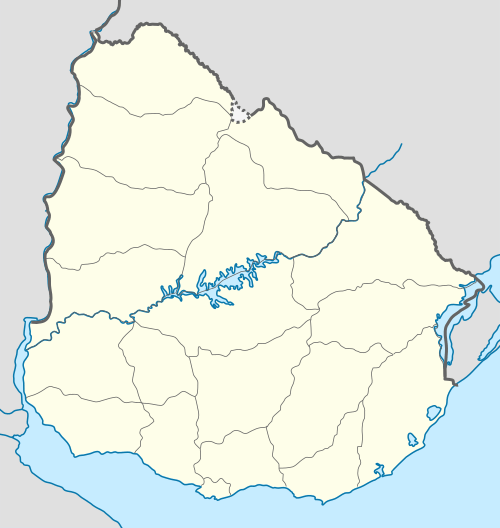Casapueblo
Casapueblo is a building constructed by the Uruguayan artist Carlos Páez Vilaró. It is located in Punta Ballena, 13 kilometres (8.1 mi) from Punta del Este, Uruguay. It was originally a summer house and workshop of the artist. Initially it was a summer house and artist's workshop, it includes in its facilities a museum, an art gallery, a cafeteria and a hotel. It was the permanent residence of its creator, where it worked and where it spent its last days.[1][2][3]
| Casapueblo | |
|---|---|
Casapueblo | |
 Location within Uruguay | |
| General information | |
| Location | Maldonado, Punta Ballena (Whale Point) |
| Coordinates | 34°54′11″S 55°2′32″W |
| Opening | 1960 |
| Owner | Carlos Páez Vilaró |
| Design and construction | |
| Developer | Carlos Páez Vilaró |
| Other information | |
| Number of rooms | 12 |
| Number of suites | 56 |
| Number of restaurants | 1 |
| Website | |
| www | |
History
It was built around a small wooden house made of planks found on the coast, called La Pionera (The Pioneer), by Carlos Páez Vilaró.[4] In a style that can be compared to the houses on the Mediterranean coast of Santorini, the artist used to refer to the nest of the hornero, a typical bird of Uruguay, when referring to this type of construction.[5] The building, which took 36 years to complete, has thirteen floors with terraces that allow one to watch optimal views of sunset on the waters of the Atlantic ocean.[6]
It houses a tribute to Carlos Miguel, the artist's son and one of the sixteen Uruguayan survivors of the plane crash of flight 571 of the Uruguayan Air Force, which crashed in the Andes on October 13, 1972.
Carlos Páez Vilaró has received some of the most important personalities from the cultural and political field, such as the writer Isabel Allende, the ambassador Mercedes Vicente, the sexologist Mariela Castro, the artist Vinícius de Moraes, among others.[5][7]
Construction
The building was built of whitewashed cement and stucco.[8] It was built in a artisanal way and without previous plans,[9] in the form of a maze,[5] it does not have straight lines inside and the color white predominates. It was expanded and modified year after year as a residence in "unpredictable ways".[10]
"La construí (Casapueblo) como si se tratara de una escultura habitable, sin planos, sobre todo a instancias de mi entusiasmo. Cuando la municipalidad me pidió hace poco los planos que no tenía, un arquitecto amigo tuvo que pasarse un mes estudiando la forma de descifrarla."
"I was built it [Casapueblo] as if it were a habitable sculpture, without plans, especially at the request of my enthusiasm. When the municipality recently asked me for the plans that I did not have, an architect friend had to spend a month studying how to decipher it.
— Carlos Páez Vilaró.[11]
Accommodation

To May, 2020 the Casapueblo Hotel has 20 rooms and suites and 50 apartments, hot pool, sauna, bar, and restaurant.[12] [13] The high season is from December to February. The apartment hotel called Hotel Casapueblo or Club Hotel Casapueblo has a restaurant called Las Terrazas (The Terraces) that follows the style of the original construction.
Museum
In the main dome of Casapueblo contains museum and workshop, where one can see part of the work of the late painter, potter, sculptor, muralist, writer, composer and builder Carlos Páez Vilaró.[14][15] It has four exhibition rooms: Nicolás Guillén Room, Pablo Picasso Room, Rafael Squirm Room, José Gómez Sicre Room, projection room, the Mermaid Terrace, Hippocampus Lookout, the Taberna del Rayo Verde (Tavern of the Green Ray) coffee shop and a boutique. The museum can be visited every day from 10 a.m. to 6 p.m.
Every afternoon since 1994 the Sun Ceremony is held on the museum's terraces. Minutes before sunset, the artist's voice from a recording, dedicates a poem to the sun to bid farewell to it.[16]
See also
References
- "Carlos Paez Vilaró: un canto a la vida" (in Spanish). El Observador. February 24, 2014. Archived from the original on August 26, 2014. Retrieved March 20, 2014.
- Sun Times (February 24, 2014). "Carlos Paez Vilaró: un canto a la vida". Retrieved March 20, 2014.
- "A mi edad, pensás en los promedios" (in Spanish). El País. Retrieved March 20, 2013.
- Casapueblo – Hotel Casapueblo. Archived June 19, 2012, at the Wayback Machine Retrieved August 8, 2010.
- Entrevista Carlos Vilaró [Carlos Vilaró Interview] (in Spanish). August 24, 2012. Retrieved March 18, 2014.
- Deco y Jardín. "Una Arquitectura muy particular" [A very particular Architecture]. Retrieved April 23, 2014.
- "Isabel Allende, de visita en Casapueblo" (in Spanish). El País. September 2013. Retrieved March 18, 2014.
- "Foto de Casapueblo cautiva a miles de usuarios de Instagram" [Photo of Casapueblo captivates thousands of Instagram users] (in Spanish). El País. 2014. Retrieved March 20, 2014.
- "Fotos de Casapueblo" (in Spanish). Archived from the original on March 21, 2014. Retrieved March 20, 2014.
- "Fallece el artista plástico Carlos Páez Vilaró" (in Spanish). El Mundo. Retrieved March 21, 2014.
- Magicas Ruinas (February 1979). "Cuando la pintura es un rito Páez Vilaró" (in Spanish). Retrieved March 20, 2014.
- Casapueblo – Hotel Casapueblo. Archived February 3, 2009, at the Wayback Machine Retrieved August 8, 2010.
- Casapueblo, Punta Ballena, Uruguay (by José Carlos de Santiago). Retrieved September 9, 2010.
- Falleció Carlos Páez Vilaró. "Falleció Carlos Páez Vilaró" (in Spanish). El País. Retrieved February 24, 2014.
- "Murió Carlos Páez Vilaró" (in Spanish). La Nación. Retrieved February 24, 2014.
- Carlos Páez Vilaró. "La Ceremonia del Sol" (in Spanish). Archived from the original on February 3, 2012. Retrieved March 17, 2014.
External links
| Wikimedia Commons has media related to Casapueblo. |
- "Club Hotel Casapueblo Punta del Este". aluruguay.com. Archived from the original on January 17, 2013. Retrieved July 5, 2014.
